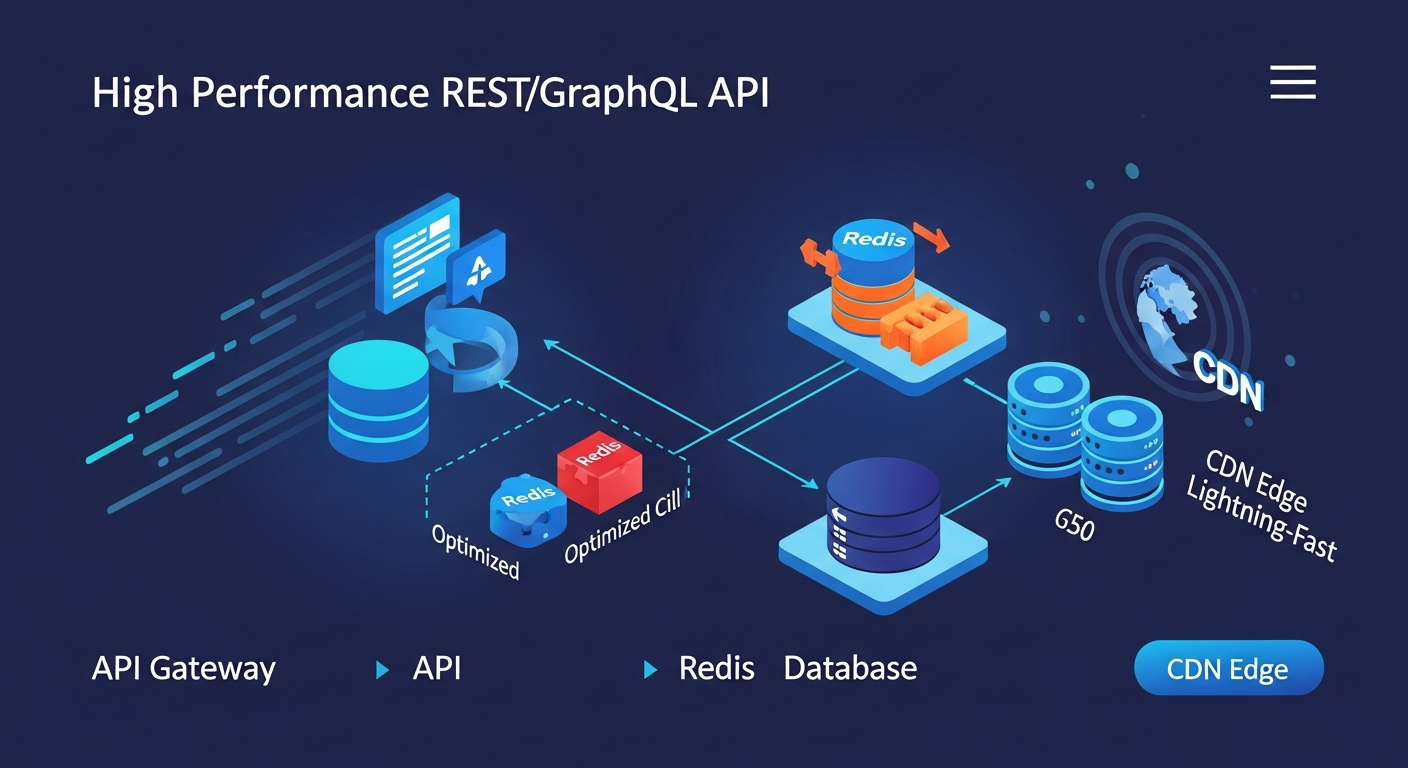Client
A fast-growing platform with increasing API traffic across mobile and web clients. Their existing API struggled with:
-
Slow response times
-
Heavy database load
-
Inefficient query patterns
-
Unpredictable performance during peak traffic
They needed a high-performance REST/GraphQL API that could scale while staying fast.
Project Overview
We redesigned and optimized the client's API layer by:
-
Improving REST and GraphQL resolver performance
-
Optimizing heavy, inefficient database queries
-
Adding Redis for caching hot data
-
Leveraging CDN caching for static/edge responses
-
Adding performance monitoring and metrics
The result:
Massively faster response times and a lighter database workload.
Key Challenges
1. Slow Endpoints
Certain API routes took 800ms to 2s, especially ones with:
-
Joins across multiple tables
-
Non-indexed fields
-
N+1 queries in GraphQL resolvers
2. Heavy Load on Database
The DB was overwhelmed due to repetitive queries from multiple services.
3. No Caching Strategy
Every request hit the database — even static data like categories or public content.
4. High Latency for Global Users
Users far from the server experienced 1–2s added latency.
Our Solution
1. REST & GraphQL API Refactoring
We improved core API architecture:
REST Improvements
-
Batch fetching
-
Reduced payload sizes
-
Query parameter validation
-
Pagination & filtering
-
Async processing for heavy tasks
GraphQL Improvements
-
Avoided N+1 query issues using DataLoader
-
Optimized resolvers for minimal DB calls
-
Field-level caching for expensive fields
-
Preloading associations
This drastically reduced backend computation.
2. Deep Database Query Optimization
We audited DB performance using tools like:
-
pg_stat_statements (Postgres)
-
EXPLAIN ANALYZE
-
Slow query logs
Optimizations included:
-
Creating missing indexes
-
Rewriting slow queries
-
Using materialized views
-
Partitioning large tables
-
Normalizing heavy data structures
Result:
Queries that took 1.2 seconds → now execute in 40–80ms.
3. Redis Caching Layer
We introduced Redis for:
✔ Hot Data Caching
-
User profiles
-
Product lists
-
Category trees
-
Frequently accessed dashboards
✔ API Response Caching
Storing complete REST/GraphQL responses.
✔ Expiry Policies
-
TTL for live data
-
Invalidation triggers for updates
✔ Session Caching (Optional)
Result:
Database load reduced 35–60% during peak time.
4. CDN Caching for Global Performance
We added CDN caching (Cloudflare/AWS CloudFront):
-
Static JSON
-
Public GET endpoints
-
Common GraphQL responses for non-authenticated users
-
Edge caching based on URL & query params
Global users now get responses in 50–150ms.
5. Background Jobs for Heavy Workflows
Tasks like:
-
Analytics updates
-
Report generation
-
Notification sending
were moved to:
-
Worker queues
-
Background jobs
-
Asynchronous processing
Reducing pressure on the main API.
6. Performance Monitoring & Metrics
We implemented:
-
Prometheus + Grafana dashboards
-
Query-level tracing
-
API latency monitoring
-
Redis hit/miss ratio tracking
Provided full visibility into performance over time.
Architecture Diagram (Text Version)
Results & Impact
⚡ Response Time Reduced by 70–90%
Heavy endpoints dropped from 1–2 seconds → 100–200ms.
💾 Database Load Reduced by 40–60%
Redis + query optimization dramatically reduced DB calls.
🌍 Global Users Experienced Faster APIs
CDN-level caching improved latency across continents.
🔒 Stable API Under High Traffic
System now stable during:
-
Sales events
-
Feature launches
-
Traffic spikes
🚀 Better Developer Experience
Clean resolvers, optimized queries, and caching reduced debugging overhead.
Conclusion
By optimizing database queries, improving REST/GraphQL design, and adding Redis + CDN caching, we built a high-performance API capable of handling heavy traffic with minimal latency and reduced infrastructure load.
The platform is now:
-
Faster
-
More scalable
-
More efficient
-
Better suited for global growth

Written by
Oliver Thomas
Oliver Thomas is a passionate developer and tech writer. He crafts innovative solutions and shares insightful tech content with clarity and enthusiasm.




